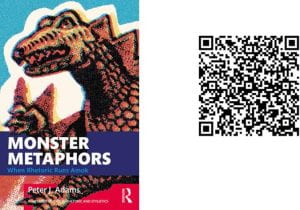I often reflect on the wide range of positive functions metaphors play in our daily lives. When I go to my family doctor, I’m likely describe my various ailments as “a shooting pain” or a “dull” ache, or “a band tightening” around my forehead. When speaking with an electrician about a wire burning out, I might talk of electricity passing like “water in a pipe” then, when it narrows, its “flow becomes constricted”. When seeking forgiveness for angry comments, I might talk of “pressure building up” or feeling “about to explode”.
Of course, pain doesn’t literally “shoot”, nor does body fluid actually “build up” to boiling point, and electricity moves only partly like “water in a pipe”. Being literal is not what metaphors are about.
The power of metaphors lies in the way they stimulate our minds in unexpected ways: at times making things more understandable, perhaps capturing something in a particularly precise way, at times encouraging new perspectives or evoking a wide range of emotions.
In this and many other ways, metaphors are indispensable to how we describe, explain and express what is happening around us, but—and it’s an important ‘but’—they have a darker side.
Every now and then a particular metaphor latches more firmly into our imaginations and manages to embed itself deep into our minds. Once embedded, the metaphor spreads and grows (I know, I’m speaking metaphorically already) and this growth is continually reinforced through links and associations.
A metaphor that has grown to dominate its terrain then reshapes the language and vocabulary that flows around it. The metaphor becomes part of the dominant narrative, ceases to be seen as a metaphor, and becomes a self-evident truth.
In my recently published book, Monster Metaphors, I look at a set of metaphors that have grown to such a size that they dominate their domains, quash alternatives and, on the basis of their supremacy, wreak havoc on those subjected to them. These metaphors include “leader as father” commonly employed by dictators, and “contagion” of terrorism.
Consider also, the mental illness metaphor, which has been around to for some time and puts forward the idea that psychological distress is best thought of as a physical illness.
There are, indeed, some aspects of being physically ill that resembles psychological distress, such as the physiological changes (such as a thumping heart when anxious) and the need for reassurance and guidance (usually from a trained professional).
But psychological distress also differs in many ways from physical illness, as can be seen in the key roles activity and social involvement play in overcoming such distress.
Despite this, over the last two centuries the mental illness metaphor has been continually reinforced by links and associations, in the way mental health services are located in medical environments for example, initially in stand-alone “psychiatric hospitals” and later as part of general hospitals, or in diagnostic procedures, case files, medication reviews and individualized practices that mark and often isolate those affected by psychological distress from their friends and families.
The vocabulary of physical illness applied in the psychological domain has included terms such as “diagnosis”, “treatment”, “recovery”, “therapy” and “prognosis”. The constantly echoing voice of the monster metaphor has meant ‘mental illness’ was no longer seen as a metaphor but more as a taken-for-granted truth.
This has contributed to a string of damaging ‘medical-like’ practices, such as lobotomies, the overuse of seclusion and sedating medication and confining people to life-long isolation in large, bleak institutions.
In my career in psychological practice, teaching and research, I have participated in a range of initiatives attempting to promote alternative understandings of psychological distress. These have included approaches that view it less as an illness and more as a product of external forces with emotional, social, economic and cultural underpinnings. In these initiatives, the role of families and communities have been central.
However, despite our best efforts, whatever we tried soon fell back into line with the monster’s preferences. I became aware that tackling a well-entrenched monster is no easy undertaking and unsettling it would take more than months, more than years, and probably more like decades of ongoing, persistent and coordinated effort.
The later chapters of Monster Metaphors explore ways in which challenging the dominance of a monster metaphors requires a sustained, collective effort that typically emerges in a sequence of social movements that combine over time, requiring multiple attempts to unsettle its dominance – just as the emancipation of woman over the last two centuries has taken a sequence of social movements, or ‘waves’, that sought to slowly challenge metaphors of male superiority.
There have been attempts to challenge the mental illness metaphor, including the ‘anti-psychiatry’ movement of the 1960-70s, the ‘psychiatric survivor’ movement of the 1970-80s, the ‘recovery movement’ of the 1980-90s, and the ‘Mad Studies’ movement of the last decade. While each of these has shaken up the monster a little, the mental health metaphor still remains firmly entrenched within our mainstream approaches to psychological wellbeing.

Don’t get me wrong here. The metaphor of mental illness has contributed, and for many people facing psychological distress, it can be helpful. What is objectionable here isn’t the metaphor per se, but its dominance; it’s dominance has acted as a barrier, preventing alternative understandings and interventions being taken seriously.
To read more: Monster Metaphors: When Rhetoric Runs Amok, (New York: Routledge, May 2023)
Text and image by Peter Adams

Recent Comments